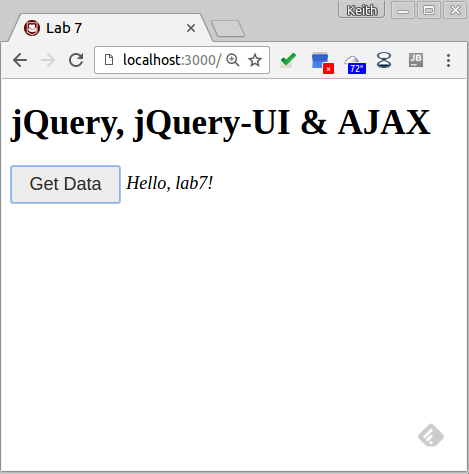JavaScript and JavaScript-based libraries can access and manipulate the
Document-Object Model(DOM).
Using jQuery
jQuery provides convenient access to the DOM.
Exercise 7.1
Work through this jQuery tutorial: How jQuery Works. Generally,
you can follow the tutorial as written, but make the following
modifications.
Load the most appropriate version of jQuery. Options:
- jQuery’s website (their CDN supported by StackPath).
- a local library (configured via NPM or downloaded
directly)
Don’t use the “slimmed” version; it doesn’t
include AJAX, which you’ll need for the next exercise.
Be sure to understand:
- the use of JavaScript anonymous functions in the context of
jQuery. Note that you don’t need to implement anything
for the “Callbacks and Functions” section of the
tutorial.
- the importance of waiting for the
ready event.
Save this code in lab07_1.html.
Using jQuery-UI
jQuery-UI provides a number client-side UI widgets.
Exercise 7.2 
Make a copy of your solution to the previous exercise, call the new
version lab07.html, and modify it to implement something
similar in function to the example shown on the right. Notes:
If you haven’t already done so, move the CSS style and JS
scripts into separate files.
Import the appropriate jQuery-UI libraries (both CSS and JS).
Replace the hyperlink from exercise 7.1 with a jQuery-UI button
or something similar (e.g., the “Get Data” button shown
to the right). See jQuery UI
Demos for examples.
Add an event handler (e.g., a button-press handler) that creates
a new DOM element that can be used to display a “no data
yet...” message (shown to the right).
$("<em>", {html: "no data
yet..."}).appendTo("body");
Note that the message should be displayed when the user presses
the button, not before. You’ll use this feature to display
data in the next exercise.
Save this code in lab07.html for use in the next exercise.
Using AJAX
The AJAX technologies support more natural, interactive interfaces. We’ll
use jQuery’s AJAX API. As a reference, you can use the “jQuery’s
Ajax-Related Methods” section of this Ajax tutorial.
Exercise 7.3 
Modify your solution to the previous exercise to implement something
similar to example shown on the right as follows.
Upgrade your server to respond to a new route,
/hello, by returning a JSON-formatted text message.
Upgrade your client code to:
Save this code in lab07.html, updating the CSS style and JS
script as needed.
Checking in
We will grade your work according to the following criteria:
- 30% — jQuery
- 30% — jQuery-UI
- 40% — Ajax

